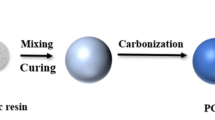Abstract
Pyrolytic resin carbon anode for lithoum ion batteries was prepared from thermosetting phenolic resin. Pyrolysis of the primary phenolic resin and the dewatered one was studied by thermal gravimetric analysis. Structures and characteristics of the carbon materials were determined by X-ray diffraction, Brunauer-Emmer-Teller surface area analysis and electrochemical measurements. With the increase of pyrolyzing temperature and soaking time, the resin carbon material has larger crystallite sizes of L c and L a, lower specific surface area, smaller irreversible capacity and higher initial coulombic efficiency. The pyrolyzing temperature and soaking time are optimized to be 1 050 °C and 2 h. The resin carbon anode obtained under the optimum conditions shows good electrochemical performances with reversible capacity of 387 mA · h/g and initial coulombic efficiency of 69.1%.
Similar content being viewed by others
References
GUO Hua-jun, LI Xin-hai, WANG Zhi-xing, et al. Mild oxidation treatment of graphite anode for Li-ion batteries[J]. J Cent South Univ Technol, 2005, 12(1): 50–54.
Hongyu W, Masaki Y, Takeshi A, et al. Characterization of carbon-coated natural graphite as a lithium ion battery anode material [J]. J Electrochem Soc, 2002, 149(4): 499–503.
GUO Hua-jun, LI Xin-hai, WANG Zhi-xing, et al. Effect of lithium or aluminum substitution on the characteristics[J]. Rare Metals, 2003, 22(4): 280–284.
Katsunori Y, Atsushi Y, Yoshinori K, et al. Carbon hybrids graphite-hard carbon and graphite-coke as negative electrode materials for lithium secondary batteries charge/discharge characteristics [J]. J Electrochem Soc, 2002, 149(7): A804–807.
Sanki G, Winans R E, Carrako K A. New carbon electrodes for secondary lithium batteries[J]. J Electrochem Soc, 1996, 143(5): 95–98.
Tokumitsu K, Mabuchi A, Fujimota H, et al. Electrochemical insertion of lithium into carbon synthesized from condensed aromatics [J]. J Electrochem Soc, 1996, 143(7): 2235–2239.
GUO Hua-jun, LI Xin-hai, WANG Zhi-xing, et al. Si-doped composite carbon as anode of lithium ion batteries[J]. Transactions of Nonferrous Metals Society of China, 2003, 13(5): 1062–1065.
Jung Y, Suh M C, Shim S C, et al. Lithium insertion into disordered carbons prepared from organic polymers[J]. J Electrochem Soc, 1998, 145(9): 3123–3129.
Wu Y P, Rahm E, Holze R. Carbon anode materials for lithium ion batteries[J]. Journal of Power Sources, 2003, 114: 228–236.
Edward B, Dahn J R. Reduction of the irreversible capacity in hard-carbon anode materials prepared form sucrose for Li-ion batteries[J]. J Electrochem Soc, 1998, 145(6): 1977–1981.
Peled E, Eshkenazi V, Rosenberg Y. Study of lithium insertion in hard carbon made from cotton wool [J]. Journal of Power Sources, 1998, 76: 153–158.
Wang S, Yata S, Nagano J, et al. A new carbonaceous material with large capacity and high efficiency for rechargeable Li-ion batteries[J]. J Electrochem Soc, 2000, 147(7): 2498–2502.
Shin R M, Takahiro H, Michiya T. et al. Reduction of irreversible capacities of amorphous carbon materials for lithium ion battery anodes by Li2CO3 addition [J]. Carbon, 2004, 42(4): 837–842.
Xiang H Q, Fang S B, Jiang Y Y. Carbonaceous anodes for lithium ion batteries prepared from phenolic resins with different cross-linking dendisties [J]. J Electrochem Soc, 1997, 144(7): 187–190.
Inagaki M. Textures in carbon materials[J]. New Carbon, 1999, 14(2): 1–13.
SENG Shi-Xiong. Technology of X-ray Diffraction [M]. Beijing: Metallurgical Industry Press, 1986. (in Chinese)
Author information
Authors and Affiliations
Corresponding author
Additional information
Foundation item: Project (50302016) supported by the National Natural Science Foundation of China; project (2005037698) supported by Postdoctoral Science Foundation of China
Rights and permissions
About this article
Cite this article
Guo, Hj., Li, Xh., Zhang, Xm. et al. Optimizing pyrolysis of resin carbon for anode of lithium ion batteries. J Cent. South Univ. Technol. 13, 58–62 (2006). https://doi.org/10.1007/s11771-006-0107-4
Received:
Accepted:
Published:
Issue Date:
DOI: https://doi.org/10.1007/s11771-006-0107-4




